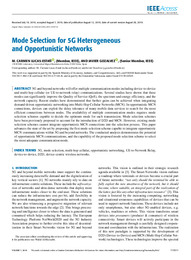Por favor, use este identificador para citar o enlazar este ítem:
https://hdl.handle.net/11000/5295Registro completo de metadatos
| Campo DC | Valor | Lengua/Idioma |
|---|---|---|
| dc.contributor.author | Lucas Estañ, María del Carmen | - |
| dc.contributor.author | Gozalvez, Javier | - |
| dc.contributor.other | Departamentos de la UMH::Ingeniería de Comunicaciones | es |
| dc.date.accessioned | 2019-10-03T09:42:00Z | - |
| dc.date.available | 2019-10-03T09:42:00Z | - |
| dc.date.created | 2019-07-19 | - |
| dc.date.issued | 2019-10-03 | - |
| dc.identifier.issn | 2169-3536 | - |
| dc.identifier.uri | http://hdl.handle.net/11000/5295 | - |
| dc.description.abstract | 5G and beyond networks will offer multiple communication modes including device-to-device and multi-hop cellular (or UE-to-network relay) communications. Several studies have shown that these modes can signi_cantly improve the Quality of Service (QoS), the spectrum and energy ef_ciency, and the network capacity. Recent studies have demonstrated that further gains can be achieved when integrating demand-driven opportunistic networking into Multi-Hop Cellular Networks (MCN). In opportunistic MCN connections, devices can exploit the delay tolerance of many mobile data services to search for the most ef_cient connections between nodes. The availability of multiple communication modes requires mode selection schemes capable to decide the optimum mode for each transmission. Mode selection schemes have been previously proposed to account for the introduction of D2D and MCN. However, existing mode selection schemes cannot integrate opportunistic MCN connections into the selection process. This paper advances the state of the art by proposing the _rst mode selection scheme capable to integrate opportunistic MCN communications within 5G and beyond networks. The conducted analysis demonstrates the potential of opportunistic MCN communications, and the capability of the proposed mode selection scheme to select the most adequate communication mode. | es |
| dc.description.sponsorship | This work was supported in part by the Spanish Ministry of Economy, Industry, and Competitiveness, AEI, and FEDER funds under Grant TEC2017-88612-R | - |
| dc.description.sponsorship | Grant TEC2014-57146-R | - |
| dc.description.sponsorship | and in part by the Generalitat Valenciana under Grant GV/2016/049. | - |
| dc.format | application/pdf | es |
| dc.format.extent | 14 | es |
| dc.language.iso | eng | es |
| dc.rights | info:eu-repo/semantics/openAccess | es |
| dc.subject | 5G | es |
| dc.subject | mode selection | es |
| dc.subject | multi-hop cellular | es |
| dc.subject | opportunistic networking | es |
| dc.subject | UE-to-Network Relay | es |
| dc.subject | device-to-device | es |
| dc.subject | D2D | es |
| dc.subject | device-centric wireless networks | es |
| dc.subject.other | 621.3 - Ingeniería eléctrica. Electrotecnia. Telecomunicaciones | es |
| dc.title | Mode Selection for 5G Heterogeneous and Opportunistic Networks | es |
| dc.type | info:eu-repo/semantics/article | es |
| dc.identifier.doi | 10.1109/ACCESS.2019.2934792 | - |
| dc.relation.publisherversion | https://doi.org/10.1109/ACCESS.2019.2934792 | - |

Ver/Abrir:
3-MCarmenLucas_Mode Selection for 5G Heterogeneous and Opportunistic Networks.pdf
5,18 MB
Adobe PDF
Compartir:
 La licencia se describe como: Atribución-NonComercial-NoDerivada 4.0 Internacional.
La licencia se describe como: Atribución-NonComercial-NoDerivada 4.0 Internacional.
.png)